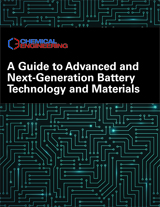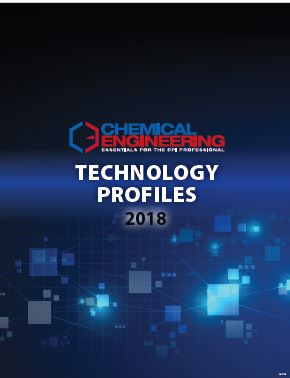Description
Chemical Engineering’s Feature Reports provide concise, factual information that aids in solving real problems. The practical, how-to orientation of these articles ensures that they can be directly applied to chemical engineers’ daily jobs. Each story applies to a relatively broad section of the chemical process industries as opposed to focusing on just one niche.
Cover Stories provides concise, factual information that aids in solving real problems. The practical, how-to orientation of these articles ensures that they can be directly applied to chemical engineers’ daily jobs. Each article applies to a relatively broad section of the chemical process industries as opposed to focusing on just one niche.
All 2017 articles are compiled into this one convenient location.
Delivered in a PDF format, 239 pages.
Articles include:
Overcoming Corrosive Processes with High-Alloyed Stainless Steels
Advanced high-alloyed stainless steels with austenitic properties can address corrosion concerns in challenging phosphoric and nitric acid processes
What’s Corroding Your Control Room?
Corrosion-induced failures are frequent in the electronics products used in control rooms, but proper environmental assessment, control and monitoring can help abate these concerns
High Purity Chemicals: Processing Equipment Essentials
Some practical tips regarding the design and fabrication of piping systems and equipment for high-purity applications are presented here
Heat Exchanger Standards for Shelland- Tube Equipment
Reliable operation of shell-and-tube heat exchangers begins with an appropriate standard. This article provides an overview of those that are applicable
Special Flange Joints Used in Floating-Head Shell-and-Tube Heat Exchangers
Single-pass, floating-head heat exchangers are common in certain process operations, but they often use flange joints that are not covered in existing design codes. Design details, advantages and disadvantages of the different options are discussed here
A Primer on Compressor Design
From initial conceptualization to final calculation, designing compressors requires not only engineering intuition and robust simulation tools, but also a bit of creativity
Control Engineering for Chemical Engineers
Chemical engineers who are aware of process control requirements and challenges are in a position to improve
process designs
Eye Protection, Part 1- Beyond Basic Eye Safety. How to protect, preserve and enhance workers’ safety
Eye Protection, Part 2- How to Avoid Fogging, A look at the hidden dangers of lens fogging and how to prevent them
Batch Drying With Vacuum Contact Dryers
Drying is a demanding unit operation where solvents need to be removed without altering product chemistry. Vacuum dryers are essential pieces of equipment for accomplishing this task
Optimizing Analysis for Spray-Drying
Precise control over spray-drying processes can be enabled by modern measurement approaches that provide information on particle size and shape in realtime
Crossflow Membrane Filtration Essentials
Several aspects of crossflow membrane filtration , including process design, equipment selection and control, are detailed here
Gas-Phase Filtration Media Properties: What to Know
There are many physical properties that can impact the ultimate performance of adsorbent media in gas-phase filtration applications
Implementing an ‘Integrity Operating Window’ Program
An effective Integrity Operating Window (IOW) program — which establishes safe operating limits and acceptable limits of process variation before an asset begins to degrade — can help operators stay ahead of potential repairs and reduce risk
Storage Tanks: Heating and Cooling System Design
Various heating or cooling options are described here, along with the factors and design parameters that need to be considered. A sample calculation regarding coils is included
Practical Solutions to Modular Project Execution
Follow this guidance to improve results on capital projects
Getting the Most from Severe Service Valves
Severe service valves (SSVs) differ from general purpose valves in important ways. Presented here is guidance on how to increase service life, reduce costs and improve safety and environmental performance of SSVs
Activated Carbon: Fundamentals and New Applications
Activated carbon sorbents are important tools in water purification and air-pollution control. This article provides information on the fundamentals of this diverse sorbent and on new applications for which it is being employed
Rupture Discs: Effectively Minimize Leaks and Emissions
When installing rupture discs, there are several mechanical and operational considerations for reducing the likelihood of leaks and fugitive emissions
Proper Sizing and Installation for Steam System Safety Valves
Successful operation of safety valves in steam systems requires careful adherence to established industry standards for installation and design
Reboiler Circuit Debottleneck with No Hardware Changes
With a thorough investigation and proper problem diagnosis, an entire gas plant limited by a deethanizer reboiler circuit was successfully debottlenecked
Dry-Tray Pressure Drop of Sieve Trays Revisited
Data points from literature are refined into a single correlation defining dry-tray pressure drop in sieve trays
Mixing: Impeller Performance in Stirred Tanks
Characterizing mixer impellers on the basis of power, flow, shear and efficiency
Drones Take to the CPI Skies
Drones are quickly entering the chemical processing space as more companies begin to embrace their use for inspection and monitoring tasks
Odor Issues and Solutions for Wastewater Treatment
Increasingly, wastewater treatment plants must address odors due to volatile contaminants. This guide provides an overview of odor causes and possible remedial actions
Smart Water- Management Strategies: The Time is Now
Considering water-management strategies as a central component of infrastructure design at industrial facilities will unlock cost savings throughout the operation
Feeder Design for Solids Handling
Processes involving the movement of bulk solid materials require careful consideration of the feeder equipment design, including how the feeders work with various bins and hoppers
Choosing Agglomeration Equipment- Part 2
A product’s intended use often dictates what type of agglomeration equipment should be used. Presented here is a discussion of the main types of equipment and methods for forming agglomerates
Valves: Emissions Standards and Current Practices
New industry standards aimed at reducing fugitive emissions have necessitated updates to valve-testing procedures and a renewed focus on high-performance sealing and packing technologies
Minimizing Leakage on Heat- Exchanger Girth Flanges
Thermal distortion in heat-exchanger internal components can lead to leakage, but several design measures can be taken to mitigate these concerns
Confronting Crystallization Issues
Reliable information about industrial crystallization can be difficult to find and to apply to new situations. The work
process outlined here will help engineers approach crystallization challenges
Cooling Towers: Keeping Your Power Plant Cool
General guidelines for selecting the appropriate power-plant cooling system are presented here
Powder and Bulk Solids Handling: Particle Size and Distribution Analysis
The size and size distribution of particles are important determining factors in the design and operation of many process operations involving dry particles and powders. Follow this guidance to understand the impact of these key characteristics
Cost Engineering Integrating Technology and Economics
The Process Synthesis Model presented here is a methodology that integrates technology and economics, thereby improving process design and reducing costs
Decommissioning: Preparing Plants for a Retrofit
As technologies advance and market challenges continue to pose new pressures for operators, the decommissioning and retrofitting of facilities is inevitable. This article provides guidance on how to tackle projects of this nature safely and efficiently
Cost Engineering Time Value of Money
Deciding whether to put a project on the fast track entails risks. Some observations are presented here to help minimize risks and maximize profits




